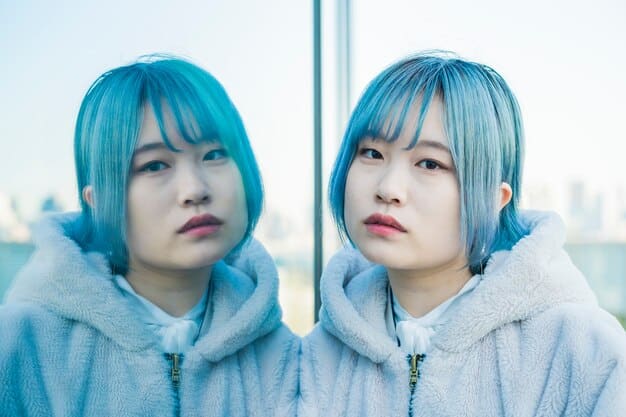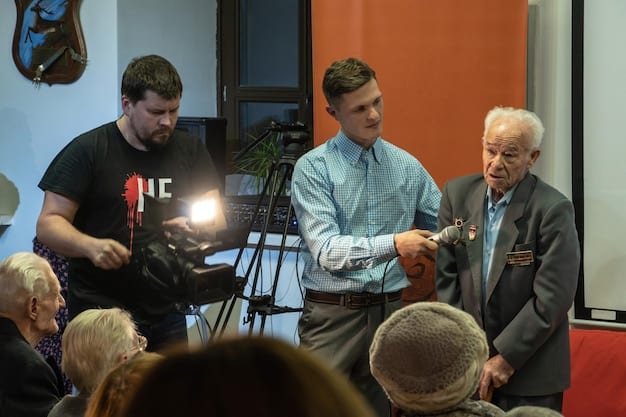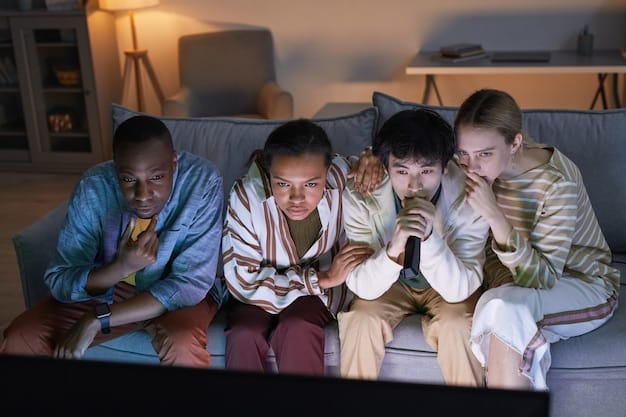Japanese Drama Remakes: Original vs. US Adaptations

Exploring the nuanced landscape of Japanese drama remakes in the US reveals fascinating insights into cultural adaptation, narrative reinvention, and audience reception, often highlighting significant deviations from their acclaimed original counterparts.
The phenomenon of Japanese drama remakes: comparing the original to the US adaptations offers a compelling lens through which to explore cultural exchange, narrative transformation, and the intricacies of bringing foreign stories to new audiences. Beyond simple translation, these adaptations often reflect broader societal values and production trends, inviting a deeper analysis of what makes a successful cross-cultural transition.
The appeal of J-dramas: a global influence
Japanese dramas, or J-dramas, have long cultivated a dedicated global following. Their unique storytelling approach, often characterized by strong emotional narratives, intricate character development, and a willingness to explore profound sociological themes, sets them apart. This distinctive style, coupled with high production quality and memorable soundtracks, contributes to their enduring appeal far beyond Japan’s borders. The influence of J-dramas extends to various entertainment industries worldwide.
The narrative structures in J-dramas frequently differ from Western storytelling conventions. They often prioritize character journeys and thematic depth over fast-paced plots. Many series delve into realistic social issues, family dynamics, and personal growth, resonating deeply with viewers who appreciate authenticity and emotional sincerity. This focus on internal struggles and subtle shifts in human relationships creates a rich tapestry that can be engaging for discerning audiences.
Unique storytelling elements
- 🎭 Character-driven plots that prioritize emotional arcs over rapid plot twists.
- 🌱 Emphasis on personal growth and societal introspection as key narrative drivers.
- 🎶 Distinctive musical scores that often become iconic and integral to the series’ emotion.
The cultural nuances embedded within J-dramas are also a significant part of their charm. Viewers are exposed to specific Japanese customs, societal norms, and etiquette, which adds an educational and immersive layer to the viewing experience. This cultural exposure fosters a deeper appreciation for Japanese arts and values, making the dramas not just entertainment but a window into another world. The subtlety in performance and the emphasis on unspoken communication are also hallmarks of the genre, offering a different kind of immersion.
In recent years, the global surge in popularity of non-English language content has further amplified the reach of J-dramas. Streaming platforms have made these shows accessible to an unprecedented number of viewers, leading to a renewed interest in their original formats. This accessibility has also laid the groundwork for more remakes, as US producers recognize the proven appeal and rich narrative potential of these Japanese stories.
Why US producers look to Japanese drama remakes
The decision to adapt a Japanese drama for a US audience is often multifaceted, stemming from a recognition of proven narrative success and a desire to tap into existing fanbases. Japanese dramas frequently come with established story arcs, well-developed characters, and a track record of high viewership, mitigating some of the risks associated with entirely original productions. This pre-existing framework offers a solid foundation upon which to build, allowing producers to focus on cultural translation rather than starting from scratch.
Moreover, certain universal themes explored in J-dramas, such as love, family, ambition, and redemption, transcend cultural boundaries. While presented through a Japanese cultural lens, the core emotional resonance of these stories can be easily adapted to speak to a Western audience. This universality makes them attractive targets for remakes, as it ensures a broad potential appeal even with significant cultural adjustments.
Factors driving US adaptations
- 📈 Proven success: Originals often have high ratings or critical acclaim, lowering investment risk.
- 📖 Rich narratives: Complex plots and character development provide a strong basis for adaptation.
- 🌍 Universal themes: Core emotional and human experiences translate across cultures.
The creative challenge of reimagining a beloved story for a new cultural context is also a driving force. Producers and writers are presented with an opportunity to interpret and evolve narratives, addressing contemporary issues or adapting the tone to suit local sensibilities. This process can be a delicate balance of preserving the original essence while making it relatable and timely for the target audience. It is about finding the sweet spot between homage and innovation.
Furthermore, the global media landscape has seen a significant increase in demand for diverse content. US networks and streaming platforms are actively seeking compelling stories from around the world to cater to an increasingly globalized viewership. Japanese dramas offer a rich source of such content, providing fresh perspectives and narrative styles that can invigorate the US television scene. The success of international adaptations across various genres suggests a strong appetite for these cross-cultural narratives.

The commercial aspect cannot be overlooked either. A successful J-drama often comes with a built-in fanbase, which can translate into initial viewership and create buzz around the remake. This pre-existing audience allows for more effective marketing strategies and can help drive initial engagement, giving the remake a head start in a competitive market.
Case study 1: ‘Hana Yori Dango’ vs. ‘Boys Over Flowers’ (South Korea) & ‘Meteor Garden’ (Taiwan/China) vs. ‘Boys Over Flowers’ (USA/unproduced)
While a direct US adaptation of “Hana Yori Dango” has faced development challenges in the past, the iconic series has seen multiple successful remakes across Asia, most notably South Korea’s “Boys Over Flowers” and Taiwan/China’s “Meteor Garden.” Examining these adaptations provides crucial insights into how a universally appealing premise can be translated, and hypothetically, what approaches an unproduced US version might have taken. The core story of a strong-willed girl from a working-class background clashing with, and eventually falling for, the leader of an elite, arrogant group of rich boys resonates deeply.
Translating the “F4” phenomenon
The F4, or “Flower Four,” are central to the appeal of “Hana Yori Dango.” In the original Japanese version, their charisma, combined with their intimidating power within the school, creates the primary conflict and romantic tension. The South Korean “Boys Over Flowers” successfully captured this dynamic, emphasizing their distinct personalities and creating a highly popular boy-band-esque appeal. “Meteor Garden” also highlighted their collective power and individual charm. A theoretical US adaptation would need to carefully cast and develop these roles to capture a similar blend of allure and antagonism, perhaps softening some of the more extreme bullying aspects to fit Western sensibilities but retaining their undeniable magnetism.
- 🌸 F4’s charisma: Key to character appeal and romantic tension.
- 😈 Balancing power: Portraying their dominance without alienating modern audiences.
- 💖 Romantic chemistry: Building a believable and evolving love triangle/square.
The female lead, Tsukushi Makino (Jan Di Geum in “Boys Over Flowers,” Shan Cai in “Meteor Garden”), represents resilience and integrity against a backdrop of opulence and bullying. Her refusal to be intimidated by the F4 challenges their authority and attracts the leader, Doumyouji Tsukasa (Gu Jun Pyo, Dao Ming Si). Any US remake would need a powerful actress to embody this spirit, ensuring her strength and moral compass are compelling to a contemporary audience. The social commentary on class differences and privilege, while present in the originals, might be further amplified or redefined to suit American societal narratives, perhaps focusing more explicitly on socio-economic disparities.
The humor and dramatic elements in “Hana Yori Dango” often rely on exaggerated reactions and slapstick, common in Japanese manga and drama. While the Asian remakes largely retained this, a US version would perhaps lean into more nuanced, character-driven comedy and less overt physical humor, integrating it more subtly into the banter and interactions. The shift from a manga-inspired aesthetic to a live-action Western drama would necessitate these changes in tone and pacing to maintain audience engagement. The challenge lies in adapting the specific cultural quirks and expressions of affection or disagreement, which are often conveyed differently across cultures, ensuring the core emotional stakes remain clear and impactful.
Case study 2: ‘Good Doctor’ (Japan) vs. ‘The Good Doctor’ (US)
The Japanese drama “Good Doctor” (2018), itself an adaptation of a highly successful South Korean series, served as the direct inspiration for the critically acclaimed US series “The Good Doctor” (2017). This provides an excellent example of a multi-country adaptation, highlighting how similar core concepts can be reinterpreted through different cultural lenses while maintaining a universal appeal. The central premise, a young surgical resident with autism and savant syndrome, faces challenges and triumphs in a prestigious hospital, offering rich dramatic possibilities.
In the Japanese “Good Doctor”, the portrayal of the protagonist, Minato Shindo, often emphasizes his internal world and the quiet struggles he faces in social interactions. The series dedicates significant screen time to illustrating his unique way of processing information and his deep empathy, despite his communication difficulties. There’s a subtle focus on how Japanese society perceives and accommodates individuals with developmental differences, though it doesn’t shy away from depicting prejudice. The series often relies on emotional depth and character-driven moments rather than high-stakes procedural drama, allowing viewers to connect deeply with Minato’s journey.
Key differences in narrative emphasis
- 🗣️ Communication styles: Japanese version subtly emphasizes non-verbal cues; US version more direct.
- 🏥 Hospital dynamics: Japanese explores traditional hierarchies; US focuses on modern medical challenges.
- 🧩 Autism portrayal: Japanese leans into internal world; US shows external impacts and advocacy.
The US adaptation, “The Good Doctor,” starring Freddie Highmore, significantly expands on the procedural aspects of the hospital setting. The American version tends to feature more complex medical cases, faster-paced storylines, and a stronger emphasis on the political and ethical dilemmas faced by the hospital staff. Dr. Shaun Murphy’s autism is a central theme, but the show also frequently uses it as a catalyst for discussion around neurodiversity, inclusion, and the definition of intelligence in a professional environment. Shaun’s journey is often framed as overcoming external obstacles and advocating for himself, which aligns with common American narrative tropes of individualism and overcoming adversity.
One of the most noticeable differences lies in the supporting characters’ relationships with the protagonist. In the Japanese version, interactions are often characterized by subtle guidance and unspoken understanding. The US version, while still portraying supportive mentors, often features more overt confrontations and explicit discussions about Shaun’s condition and his integration into the team. The emotional beats, while present in both, are communicated with differing levels of directness, reflecting cultural norms around emotional expression. The US version might also feature a larger ensemble cast, allowing for more diverse subplots and exploring a wider range of character backgrounds.
Both adaptations have been successful in their respective markets, demonstrating the powerful human story at the core of the concept. The Japanese version received critical acclaim for its sensitive portrayal, while the US version garnered significant viewership and awards, highlighting its widespread appeal. This dual success underscores that while cultural tailoring is essential, a compelling premise can thrive across various interpretations.
Case study 3: ‘Mothers and Daughters’ (Japan) vs. ‘This Is Us’ (US)
While not a direct, acknowledged remake, the thematic and structural similarities between the acclaimed Japanese drama “Mothers and Daughters” (2015, known in Japan as “Haha to Ko”) and the massively popular US series “This Is Us” (2016-2022) invite compelling comparisons about how family sagas are presented across cultures. Both series intricately weave together the lives of multiple family members across different timelines, exploring profound emotional bonds, generational trauma, and the complexities of human relationships. Neither show shies away from difficult subjects, from adoption and loss to identity formation.
“Mothers and Daughters” delves deeply into the lives of a set of mothers and their children, often focusing on the quiet sacrifices, unspoken burdens, and profound love that bind them. The narrative unfolds with a poignant, often melancholic tone, allowing ample space for introspection and the nuanced exploration of internal emotional landscapes. The Japanese version tends to use flashbacks with a softer, sometimes more ambiguous, touch, letting viewers piece together fragments of the past to understand present dynamics. The series explores themes of identity tied closely to family lineage and societal expectations.
Narrative and thematic contrasts
- ⏳ Timeline manipulation: Japanese uses subtle hints; US employs clear, distinct time jumps.
- 💔 Emotional expression: Japanese values restraint; US embraces overt emotionality.
- 👪 Family roles: Japanese adheres to traditional structures; US explores evolving definitions.
“This Is Us,” on the other hand, is renowned for its signature non-linear storytelling, with clearly delineated jumps between different eras – the childhoods of the “Big Three,” their adult lives, and pivotal moments in their parents’ past. This structural choice is used to build suspense, deliver emotional reveals, and highlight the enduring impact of childhood experiences on adult personalities. The US series often leans into highly emotional, cathartic moments, encouraging viewers to openly engage with the characters’ pain and triumphs. It also frequently uses grand gestures and impactful dialogues to convey its emotional weight, a characteristic of many American family dramas.

The portrayal of family dynamics also differs. “Mothers and Daughters” often explores the implicit expectations and responsibilities within traditional Japanese family structures, the pressures of societal approval, and the quiet ways individuals cope with fate. “This Is Us,” conversely, emphasizes the American ideals of self-discovery, individual expression, and the active pursuit of happiness and fulfillment, even within the context of family. While both tackle universal themes like adoption, the emotional fallout of loss, and complex sibling relationships, their approaches reflect their cultural origins.
For instance, the adoption storyline in “Mothers and Daughters” might focus on the biological mother’s silent struggles and the adopted child’s subtle search for roots, with emphasis on the societal aspect of belonging. In “This Is Us,” the adoption of Randall and his subsequent search for his biological parents is a bold, central narrative arc, full of dramatic confrontations and explicit emotional processing. Both series exemplify excellence in their respective narrative styles, demonstrating how the complex tapestry of family life can be universally captivating, yet culturally distinct in its execution.
The delicate act of cultural adaptation
Adapting a foreign drama for a new cultural context is a nuanced process that extends far beyond simple translation of dialogue. It involves a fundamental reimagining of narratives, characters, and themes to resonate with a target audience while ideally honoring the spirit of the original. This delicate act requires a profound understanding of both the source culture and the receiving culture, recognizing where universal human experiences intersect and where distinct cultural norms diverge.
One of the primary challenges lies in translating humor and emotional expression. What might be perfectly comedic or deeply moving in one culture could fall flat or even be misinterpreted in another. Japanese dramas, for example, often employ subtle non-verbal cues, understated emotional reactions, and specific forms of etiquette that are central to character interaction. Directly transplanting these into a Western context without modification can lead to characters appearing aloof, expressionless, or even rude to a US audience accustomed to more overt emotionality and direct communication styles. Thus, writers must find equivalent expressions that convey the same intent without losing the original essence.
Challenges in cross-cultural remakes
- 🎭 Translating humor: Jokes and comedic timing are highly culture-specific.
- 🗣️ Adapting dialogue: Ensuring natural phrasing while keeping original intent.
- 🎨 Tone modulation: Aligning emotional intensity with audience expectations.
Beyond emotional nuances, societal norms, values, and even the pace of daily life play a significant role. Themes like family honor, community obligations, or specific hierarchical structures, which might be central to a Japanese narrative, may need to be reinterpreted or de-emphasized for a US audience that might prioritize individualism or different societal pressures. The pacing of a drama is also critical; many Japanese dramas unfold at a more contemplative pace, allowing for character development and atmospheric immersion. US audiences, especially in network television, often prefer faster-paced narratives with frequent plot developments and cliffhangers, necessitating structural adjustments in remakes.
The visual aesthetics also demand attention. Set design, fashion, and even lighting can carry cultural connotations. Recreating an authentic Japanese classroom or office environment might not resonate with a US audience; instead, the aesthetic needs to reflect common US settings while still conveying the original story’s atmosphere. Furthermore, certain plot devices or character motivations rooted in specific cultural myths, folk tales, or historical events will likely require significant alteration or replacement with culturally familiar parallels to maintain relevance and impact.
Ultimately, a successful cultural adaptation isn’t about perfect replication but about intelligent transformation. It’s about discerning the universal truths and compelling narratives within the original work and finding fresh, culturally appropriate ways to present them to a new audience, ensuring that the heart of the story remains intact while its skin adapts to a new environment.
Audience reception and critical takes on remakes
The reception of Japanese drama remakes in the US is often a mixed bag, reflecting the inherent challenges of cross-cultural adaptation. While some remakes garner critical acclaim and widespread popularity, others struggle to capture the magic of their originals or face backlash from loyal fans. This varied reception underscores the delicate balance between faithful adaptation and necessary reinvention.
For remakes that succeed, like “The Good Doctor,” a key factor is often their ability to translate the core emotional appeal and compelling premise without merely replicating the original. These adaptations tend to Americanize the setting and character interactions in a way that feels organic rather than forced. They often bring a fresh perspective, perhaps deepening certain character arcs or expanding on particular themes that resonate strongly with US audiences. Critical praise for such shows often highlights their ability to stand on their own as compelling television, even for viewers unfamiliar with the source material.
Factors influencing remake reception
- ✨ Originality in adaptation: How well it reinterprets, not just copies.
- 🗣️ Cultural resonance: How effectively it connects with the target audience.
- 💙 Fan base reaction: Balancing respect for the original with new creative choices.
However, remakes often face scrutiny from devoted fans of the original J-dramas. These viewers, having a deep connection to the source material, frequently compare every aspect of the remake, from casting choices and character portrayals to plot deviations and tonal shifts. When a remake strays too far from the original’s perceived essence, or if it simplifies complex storylines for a broader audience, it can be met with criticism. Fans often argue that such adaptations lose the unique charm or depth that made the original beloved, perceiving them as superficial or culturally insensitive.
Industry critics also weigh in on the effectiveness of these adaptations. Their reviews often focus on the narrative coherence, acting performances, and production quality, but they also evaluate the remake’s ability to justify its existence beyond mere re-packaging. Questions arise about whether the remake offers a new artistic vision or simply capitalizes on a proven concept. The commercial success of a remake, measured by ratings and streaming numbers, provides another layer to its reception. High viewership can indicate effective adaptation strategies, even if critical opinions are divided.
Ultimately, the broad spectrum of audience and critical reception for Japanese drama remakes signifies the complex interplay between cultural heritage, creative ambition, and commercial viability. Each remake serves as a valuable case study in the evolving landscape of global television, demonstrating the perpetual challenge and opportunity in bridging diverse storytelling traditions.
The future of Japanese drama remakes: trends and possibilities
The landscape of cross-cultural television adaptations is continually evolving, and the future of Japanese drama remakes in the US appears to be dynamic and full of potential. Several trends suggest a continued interest in adapting J-dramas, while new possibilities emerge for how these stories might be reimagined for new audiences. The increasing global accessibility of original content through streaming platforms is a key factor shaping this future.
One clear trend is the growing emphasis on “glocalization,” where adaptations strive to retain the international appeal of the original while deeply embedding local cultural nuances. This involves moving beyond superficial changes to a more profound reimagining of themes, social issues, and character motivations to resonate authentically with the target audience. Future remakes might also explore genres less frequently adapted, moving beyond romance and medical dramas to historical epics, supernatural thrillers, or intricate mysteries that showcase the breadth of Japanese storytelling.
Emerging trends in adaptations
- 🌐 Glocalization: Embedding local flavor while keeping universal appeal.
- 🤔 Diverse genres: Exploring new types of stories for adaptation.
- 🤝 Co-productions: Collaborative efforts to bridge cultural gaps.
The rise of streaming services could also facilitate more niche adaptations. With less pressure to appeal to a broad, traditional television audience, streamers might take risks on J-dramas with more unique premises or avant-garde narrative structures. This could lead to more faithful adaptations in some instances, allowing culturally specific elements to remain intact for a discerning global viewership. Conversely, it could also foster bolder experimentation, where the original serves as a loose inspiration for a completely new narrative.
Furthermore, the increasing awareness and appreciation for diverse cultures among US audiences, partly fueled by the popularity of K-pop, anime, and other international media, might lead to a greater openness towards narratives that do not perfectly fit conventional Western molds. This could mean that future remakes might perform less extensive “Americanization,” allowing more of the original Japanese ethos to shine through without jeopardizing mass appeal. Collaborative productions, involving both Japanese and US creative teams, could also become more common, ensuring cultural authenticity while tailoring for a wider market.
The future might also see a shift from direct scene-by-scene remakes to more intellectual property (IP) acquisition, where only the core concept or characters are bought, leaving the production team free to create a largely original story within that framework. This approach offers maximum creative freedom while leveraging the established recognition of a successful Japanese property. Ultimately, as the world becomes more interconnected, the exchange of stories across borders will only intensify, making Japanese dramas a continued and vital source of inspiration for global television.
| Key Aspect | Comparison Point |
|---|---|
| 🎭 Cultural Nuances | Japanese originals often feature subtle emotional cues and societal norms; US remakes tend to be more overt. |
| ⚡ Pacing & Structure | J-dramas can be slower, character-driven; US versions often adopt faster, plot-driven narratives. |
| 📈 Remake Success | Successful remakes balance faithful adaptation with necessary reinvention for local appeal. |
| 🔮 Future Trends | Increasing glocalization, diverse genres, and cross-cultural collaborations expected. |
Frequently asked questions about Japanese drama remakes
Japanese dramas typically feature more character-driven narratives, often exploring social themes and emotional complexities with subtle expressions. They might also have a slower pace and utilize unique cultural nuances in storytelling compared to the generally faster-paced, plot-heavy, and more overtly emotional US dramas. This distinction often means remakes require significant cultural reinterpretation.
US producers are drawn to J-dramas for their proven narrative success, compelling story concepts, and established fan bases. Adapting a pre-existing story reduces some of the risks associated with entirely original productions and allows them to tap into universal themes that resonate across different cultures. It also caters to a growing demand for diverse international content.
The faithfulness of US remakes varies significantly. While some aim to retain the core narrative and character arcs, most undergo substantial cultural adaptation. This includes modifying dialogue, emotional expression, societal contexts, and pacing to better suit the US audience. Direct, scene-by-scene remakes are rare, as tailoring is often necessary for broader appeal.
One prominent example of a successful US remake is “The Good Doctor,” which was adapted from the Japanese drama of the same name (which itself was a South Korean original). While direct US remakes are not as numerous as, for instance, Korean drama adaptations, the concepts from J-dramas often inspire successful Western series indirectly.
Challenges include translating subtle humor and emotional cues, adapting culturally specific societal norms and values, and adjusting the narrative pace to fit diverse audience expectations. Striking the right balance between honoring the original’s essence and making it relatable to a new audience without alienating existing fans is a constant tightrope walk for producers.
Conclusion
The journey of Japanese dramas migrating to US screens as remakes is a fascinating study in cultural translation and narrative evolution. While fraught with the complexities of adapting deeply rooted cultural nuances for a new audience, these endeavors highlight the universal appeal of compelling storytelling. The differences between original J-dramas and their US counterparts often illuminate the distinct values, communication styles, and narrative preferences of both cultures, offering viewers a unique opportunity to appreciate diverse approaches to drama. As global media continues to intertwine, the art of the remake will undoubtedly refine, promising even more sophisticated and thought-provoking cross-cultural adaptations in the years to come.





